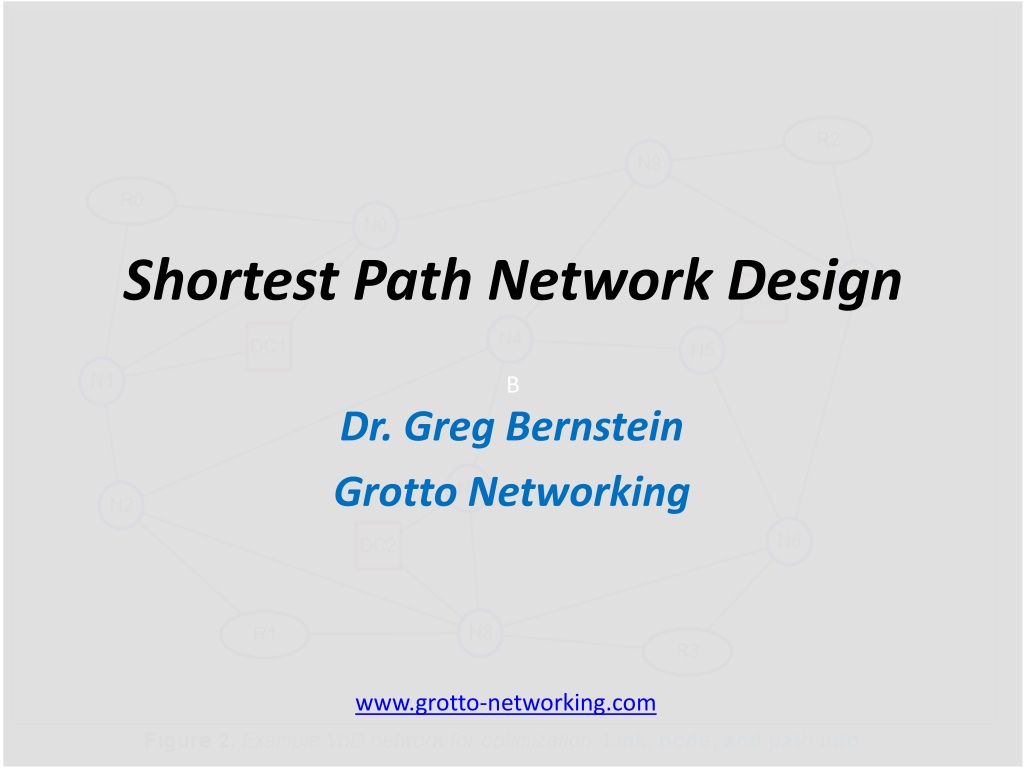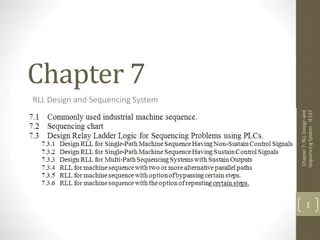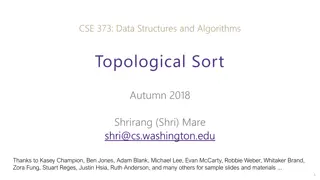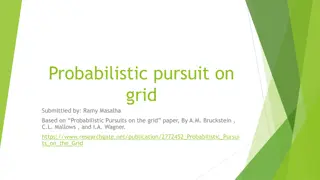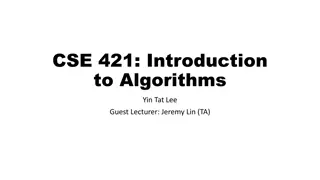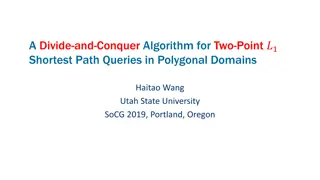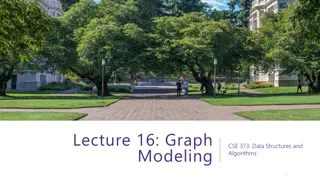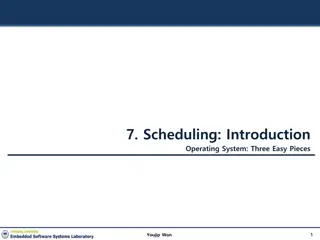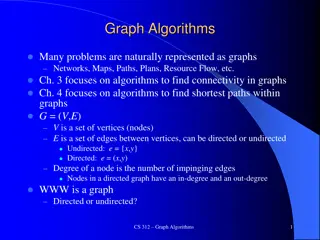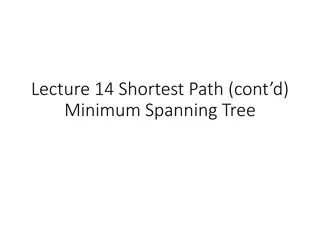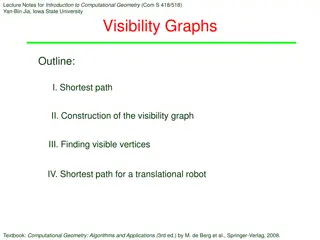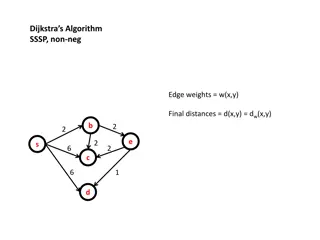Shortest Path Network Design
This content delves into the design of shortest path networks focusing on technology-specific path choice restrictions for IP and Ethernet protocols like OSPF, IS-IS, TRILL, and 802.1aq. It explores the implications of path choice restrictions, discusses loops in TDM networks, and highlights the inefficiencies and solutions related to loops in circuit paths.
Download Presentation

Please find below an Image/Link to download the presentation.
The content on the website is provided AS IS for your information and personal use only. It may not be sold, licensed, or shared on other websites without obtaining consent from the author.If you encounter any issues during the download, it is possible that the publisher has removed the file from their server.
You are allowed to download the files provided on this website for personal or commercial use, subject to the condition that they are used lawfully. All files are the property of their respective owners.
The content on the website is provided AS IS for your information and personal use only. It may not be sold, licensed, or shared on other websites without obtaining consent from the author.
E N D
Presentation Transcript
Shortest Path Network Design B Dr. Greg Bernstein Grotto Networking www.grotto-networking.com
Outline Technology Specific Path Choice Restrictions IP & Ethernet Shortest Path Based Protocols IP: OSPF, IS-IS Ethernet: TRILL, Shortest Path Bridging (802.1aq) Link Weight Optimization Problem MIP Formulation Book Readings Sections:2.5, 3.1, 7.1.1, 7.2.1
Path Choice Restrictions The No Loop Rule No active path between a communications source and sink should ever contain a loop. Application of this rule to specific data plane and/or control plane results in a set of path choice restrictions We will investigate the following: TDM/WDM Circuits, Virtual Circuits; IP and Ethernet with various control planes including OpenFlow
Paths with Loops in TDM Networks? Could I set up the path [N1, N2, N3, N4, N2, N3, N7, N8]? What would example cross connect tables look like?
Loops in TDM networks II Path [N1, N2, N3, N4, N2, N3, N7, N8] X-connect tables N1 X:X; P1: TS1 N2 P1:TS1; P2: TS3 P3:TS7; P2: TS5 N3 P1:TS3; P3: TS1 P1:TS5; P2: TS2 N4 P3:TS1; P1: TS7 N7 P1:TS2; P4: TS3 N8 P1:TS3; X:X
Whats Wrong with Loops in TDM? Resources are wasted! For at least one link resources are carried twice Example [N1, N2, N3, N4, N2, N3, N7, N8] Link (N2, N3) carries the same traffic twice If this was an G.709 OPU2 signal we would have wasted 10Gbps of capacity on link (N2, N3) Extremely Easy to Detect & Prevent A node shows up twice in the paths node list A connection uses the same switch port twice
Loops in Circuit Paths Could be created with TDM, WDM (with wavelength conversion), Virtual Circuits Almost always prevented by Control plane or management plane In Network Design we only use k loopless paths algorithms to generate candidate paths Also known as simple paths Without this restriction it is easier to generate the k shortest paths, but these are not useful for our network design purposes [1]J. Hershberger, M. Maxel, and S. Suri, Finding the k shortest simple paths: A new algorithm and its implementation, ACM Trans. Algorithms, vol. 3, no. 4, p. 45, 2007. [2]D. Eppstein, Finding the k Shortest Paths, SIAM J. Comput., vol. 28, no. 2, pp. 652 673, Jan. 1998. Loopless With Loops
Loops with Datagram Forwarding Destination Based Forwarding Used in IP and Ethernet How could a loop arise when sending a packet from N1 to N8?
Loops in Datagram Forwarding Bad Forwarding tables: N1 to N8? N1 Table N8: P2 N2 Table N8: P2 N8 N3 Table N8: P3 N4 Table N8: P1 N7 Table N8: P4
Loops in Datagram Forwarding Prevention IP: make sure paths to every destination resulting from routing tables are loop free form a tree. Ethernet (learning bridge control plane): Reduce network to a tree topology, i.e., disable some links (but this throws away bandwidth) Mitigation IP has a Time to Live (TTL) counter that is decremented at each hop Ethernet frames do not have a TTL counter
Trees for Paths A spanning tree for a connected graph contains all the nodes and no loops Just enough of the links are kept for connectivity Can compute the number of spanning trees via Kirchhoff's matrix tree theorem (https://en.wikipedia.org/wiki/Kirchhoff%27s_theore m) Implications Ethernet (learning bridge) must select one tree for network topology (determines all paths) IP must select one tree for each destination N trees total (determines all paths to the destination)
Trees for Paths II Examples ???????? 1.0303 1023 79 trees L6 N7 N4 L4 N3 L2 L11 L9 L8 L5 N2 N6 L1 L7 L3 N1 N5
Trees for Paths III Too many trees? Want to make a good choice so choose shortest path trees IP Routing Open Shortest Path First (OSPF) routing protocol IS-IS routing protocol Ethernet (beyond learning bridge) Shortest Path Bridging (IEEE 802.1aq-2012) TRILL (Transparent Interconnection of Lots of Links) IETF working group -- http://datatracker.ietf.org/wg/trill/
TRILL RFC5556 Abstract Current IEEE 802.1 LANs use spanning tree protocols that have a number of challenges. These protocols need to strictly avoid loops, even temporary ones, during route propagation, because of the lack of header loop detection support. Routing tends not to take full advantage of alternate paths, or even non- overlapping pairwise paths (in the case of spanning trees). This document addresses these concerns and suggests applying modern network-layer routing protocols at the link layer. J. Touch, R. Perlman, RFC5556, Transparent Interconnection of Lots of Links (TRILL): Problem and Applicability Statement, May 2009
TRILL RFC6325 1.1. Algorhyme V2, by Ray Perlner I hope that we shall one day see A graph more lovely than a tree. A graph to boost efficiency While still configuration-free. A network where RBridges can Route packets to their target LAN. The paths they find, to our elation, Are least cost paths to destination! With packet hop counts we now see, The network need not be loop-free! RBridges work transparently, Without a common spanning tree. RFC6325, Routing Bridges (RBridges): Base Protocol Specification, July 2011.
RFC3251 The Best Every Written? Digression Abstract Mostly Pointless Lamp Switching (MPLampS) is an architecture for carrying electricity over IP (with an MPLS control plane). According to our marketing department, MPLampS has the potential to dramatically lower the price, ease the distribution and usage, and improve the manageability of delivering electricity. This document is motivated by such work as SONET/SDH over IP/MPLS (with apologies to the authors). Readers of the previous work have been observed scratching their heads and muttering, "What next?". This document answers that question. Bala Rajagopalan, RFC3251, Electricity over IP, April 1, 2002.
How does TRILL work? I New Ethertype for TRILL TRILL frame types TRILL Data frames (TRILL encapsulated data frames) TRILL control frames Other TRILL frames Still uses Ethernet Frames
How does TRILL work? II TRILL Header Includes hop count for loop control Forwarding known destinations uses shortest path unknown destinations uses distribution tree and then learns addresses.
IEEE Shortest Path Bridging I IEEE 802.1aq Somewhat difficult to read, better in depth article: https://en.wikipedia.org/wiki/IEEE_802.1aq The technology provides logical Ethernet networks on native Ethernet infrastructures using a link state protocol to advertise both topology and logical network membership. Packets are encapsulated at the edge either in mac-in-mac 802.1ah or tagged 802.1Q/802.1ad frames and transported only to other members of the logical network. Unicast, multicast, and broadcast are supported and all routing is on symmetric shortest paths.
IEEE Shortest Path Bridging II IEEE 802.1aq https://en.wikipedia.org/wiki/IEEE_802.1aq Shortest path bridging (IEEE 802.1aq) is the replacement for the older Spanning Tree Protocols (IEEE 802.1D STP, IEEE 802.1w RSTP, IEEE 802.1s MSTP) which permitted only a single path toward the root bridge and blocked any redundant paths which could result in a layer 2 loop. The control plane is based on IS-IS with a small number of extensions defined in RFC 6329. Which will win TRILL or SPB? Or will SDN make them both obsolete
Network Design with Shortest Path Routing Assume network is in place Only knobs we can adjust are the link weights All Shortest Path based protocols provide (require) the setting of link weights What to optimize for? Minimize link congestion, i.e., minimize overall link utilization across the network
Shortest Path Design Problem I Givens: Demands Link Capacities Network topology Variables Link weights (integers) Candidate paths (dependent) Link load (dependent) = 1,2, , d D dh = 1,2, , e E ec = w x ( , , , ) w w ( ) w w 1 2 E dp ey w ( )
Shortest Path Design Problem II Constraints: Demands satisfaction Link Utilization Link Capacity Objective Minimize the maximum utilization over all links y = ( ) w = c x h dp d p ( ) w x e edp dp d p ( ) w y e e w min max { ( )/ w } y c e e e
Shortest Path Design Problem III Simplification Introduce supplementary variable r Constraints: Demands satisfaction Link Capacity Objective Minimize the maximum utilization over all links min r = ( ) w x h dp d p x c r edp dp e d p w
Shortest Path Design Problem IV Issue The previous formulation is not linear. Complicated dependency of shortest paths on link weights. Many approaches have been taken to this problem. A MIP formulation given in section 7.2.1 of P&M This is an innovative node link formulation but I have not verified it See instead: K. Holmberg and D. Yuan, Optimization of Internet Protocol network design and routing, Networks, vol. 43, no. 1, pp. 39 53, Jan. 2004.
